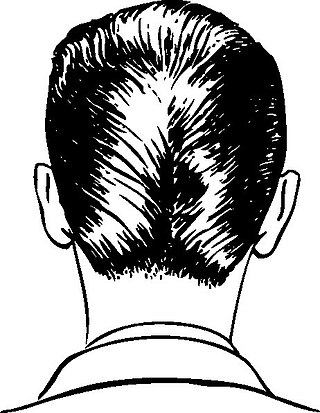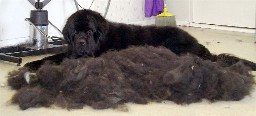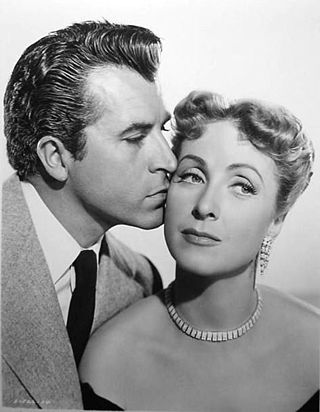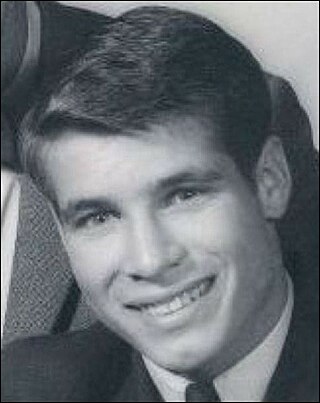
A flattop is a type of haircut where the hair on the top of the head is cut and styled upright to form a flat profile when viewed from the front or side.

A flattop is a type of haircut where the hair on the top of the head is cut and styled upright to form a flat profile when viewed from the front or side.
In the most classic style of flattop for men and boys, the hair on top of the head is styled upright and cut flat from front to back before contouring to the crown at the back of the head. The shortest hair on top, which is at the highest point on the head, is cut to about a quarter of an inch long, resulting in hair at the front being about 3/4 to 1-1/4 inches, depending on the roundness of the head. The back and sides are cut to about a quarter of an inch (usually the same length or slightly shorter than the length of the shortest hair on top) and tapered into the upright hair. The ears are cleanly outlined and the sideburns are squared just above the orifice of the ear. The neckline is cut with a low taper.
Other versions popular in counter-culture are left longer on the top and often taper upwards from crown to a length of 2-3 inches in the front, or with a modified back and sides which are alternatively left long or shaved to the skin. A variant form known by names including "flattop with fenders" and "flat top boogie" has long sides known as fenders. Another version, often worn by soldiers in the U.S. military, shaves the hair to the skin from the highest point on the back of the crown all the way down the back and sides with lather and razor, leaving only enough hair on top for the shortest of flattops, resulting in the hair on top resembling a horseshoe shape on top. This is known as a “horseshoe flattop” or “shoe”. Regardless of the form, the flattop is usually cut with electric clippers, using both the clipper-over-comb and freehand techniques on the top and detachable blades on the back and sides. [1] [2] [3] [4]
Flattops are typically groomed with wax pomade (known as butch wax in the 1950s [5] ), hair spray, mousse, gel, or cream—depending upon hair texture and the preference of the wearer regarding stiffness and shine of the upright hair. Some with especially coarse hair textures do not require product to maintain their hold, though most must style their flattop with a blow dryer and styling product of choice. Since the hair is cut very short and quickly grows out of its precise shape, maintenance haircuts are required at every 2-3 weeks, and some flattop wearers visit their barber weekly—and often on Fridays, resulting in a phenomenon barbers call "Flattop Friday". [6] [7]
When a flattop haircut is viewed from the front, varying degrees of squarish appearance are achieved by the design of the upper sides as they connect to the flat deck. [8] [9] Possibilities are somewhat limited by skull shape, density of the hair, and diameter of the individual shafts of hair, but may include: boxy upper sides with rounded corners; boxy upper sides with sharp corners; rounded upper sides with rounded corners; and rounded upper sides with sharp corners. [8] Natural skull shape and certain deck inclinations and heights often leave an area at the center top of the head where the scalp is visible through the hair. This area is called a "landing strip", a metaphor for the landing strip on the deck of a flattop (aircraft carrier). Some flattops are designed to cause a landing strip to show to varying degrees. [9] Whether or not the wearer wishes to have a landing strip is a typical discussion point when getting a flattop. While most all of a flattop is cut with clippers, master barbers with an attention to detail use shears at the end of the haircut to confirm that no stray hairs remain on top, which is known as giving the patron a “scissor salute”.
The flattop was popular in the early and mid 20th century, see photos below, and maintains a contingent of dedicated wearers today. It is considered a classic, short male hairstyle.

The hair on the lower two-thirds of the sides and back of the head are cut using the direct contact clipper method, with a 1/4 inch or shorter attached guard or detachable blade. Care must be taken to "box in" the flattop using the clipper-over-comb method on the upper third of the sides rather than contour it to the head. This is accomplished by holding a vertically-oriented comb directly to the side of the head and running the clippers upwards on the comb. On the back, the hair is typically more contoured to the crown. The top hair is typically cut with clippers utilizing the clipper-over-comb technique, though it can also be cut shears-over-comb. When the top hair is well-styled, often referred to by barbers as "trained", the top can be cut freehand with a clipper to best adjust the shape of the flattened top to the shape of the head or preference of the wearer. [10] [11] Some barbers utilize a large 4-inch wide comb designed for cutting flattops, while others use wide rotary clipper blades specifically designed for freehand cutting the top of a flattop. [12] However, for master barbers, these specialized tools are normally not required or used.

A hairstyle, hairdo, haircut or coiffure refers to the styling of hair, usually on the human head but sometimes on the face or body. The fashioning of hair can be considered an aspect of personal grooming, fashion, and cosmetics, although practical, cultural, and popular considerations also influence some hairstyles.

A buzz cut, or wiffle cut, is a variety of short hairstyles, especially where the length of hair is the same on all parts of the head. Rising to prominence initially with the advent of manual hair clippers, buzz cuts became increasingly popular in places where strict grooming conventions applied. In several nations, buzz cuts are often given to new recruits in the armed forces. However, buzz cuts are also used for stylistic reasons.

A bob cut, also known as a bob, is a short to medium length haircut, in which the hair is typically cut straight around the head at approximately jaw level, and no longer than shoulder-length, often with a fringe at the front. The standard bob cut exposes the back of the neck and keeps all of the hair well above the shoulders.

The high and tight is a military variant of the crew cut. It is a very short hairstyle, characterized by the back and sides of the head being shaved to the skin and the option for the top to be blended or faded into slightly longer hair. It is most commonly worn by men in the U.S. armed forces. It is also popular with law enforcement officers and other public safety personnel. Although "high and tight" is the primary term used in military and law enforcement, the same haircut is sometimes referred to by civilians as a "walker".

A crew cut is a type of haircut in which the upright hair on the top of the head is cut relatively short, graduated in length from the longest hair that forms a short pomp (pompadour) at the front hairline to the shortest at the back of the crown so that in side profile, so the outline of the top hair approaches the horizontal. Relative to the front view, and to varying degrees, the outline of the top hair can be arched or flattened at the short pomp front and rounded or flattened over the rest of the top to complement the front hairline, head shape, face shape and facial features. The hair on the sides and back of the head is usually tapered short, semi-short, or medium.

The mohawk is a hairstyle in which, in the most common variety, both sides of the head are shaven, leaving a strip of noticeably longer hair in the center. Mohawk hairstyles have existed for thousands of years. As of the 21st century, they are most commonly associated with punks, or broader non-conformity.

The ducktail is a men's haircut style popular during the 1950s. It is also called the duck's tail, duck's ass, duck's arse, or simply D.A. and is also described as slicked back hair. The hair is pomaded (greased), combed back around the sides, and parted centrally down the back of the head.

A bowl cut is a simple haircut where the front hair is cut with a straight fringe and the rest of the hair is left longer, the same length all the way around, or else the sides and back are cut to the same short length. It is named so because in medieval times, when it was popular in Europe, a bowl would be placed on the head and then used as a cutting guide to trim the hair.

A hair clipper, often individually called the apparent plurale tantumhair clippers, is a specialised tool used to cut human head hair. Hair clippers work on the same principle as scissors, but are distinct from scissors themselves and razors. Similar but heavier-duty implements are used to shear sheep, but are called handpieces or machine shears.

An induction cut, also referred to as a mighty fine, is the shortest possible hairstyle without shaving the head with a razor. The style is so named as it is traditionally the first haircut given to new male recruits during initial entry into many of the world's armed forces, but most particularly in the United States.

Dog grooming refers to both the hygienic care and cleaning of a dog, as well as a process by which a dog's physical appearance is enhanced for showing or other types of competition. A dog groomer is a person who earns their living grooming dogs.
Hairstyling tools may include hair irons, hair dryers, hairbrushes, hair rollers, diffusers and various types of scissors.

Hairstyle fashion in Rome was ever changing, and particularly in the Roman Imperial Period there were a number of different ways to style hair. As with clothes, there were several hairstyles that were limited to certain people in ancient society. Styles are so distinctive they allow scholars today to create a chronology of Roman portraiture and art; we are able to date pictures of the empresses on coins or identify busts depending on their hairstyles.

A brush cut is a type of haircut in which the hair on the top of the head is cut short in every dimension. The top and the upper portion of the back and sides are cut the same length, generally between 1⁄4 and 1⁄2 inch, following the contour of the head. The hair below the upper portion of the sides and back of the head is tapered short or semi-short with a clipper, in the same manner as a crew cut. A variant form may have a slight graduation of the top hair longer from back to front or a quickly graduated bit of hair at the front hairline to achieve a little flip up of the hair at the forehead. A brush that is cut at less than 1⁄4 inch on top may be referred to as a burr. A brush that is cut at 1⁄4 inch or longer on top, and especially one that shows natural curl, depending on length, may be referred to as a short brush cut or brush cut. Brush cuts are traditionally groomed with hair control wax, commonly referred to as brush wax.
The undercut is a hairstyle that was fashionable from the 1910s to the 1940s, predominantly among men, and saw a steadily growing revival in the 1980s before becoming fully fashionable again in the 2010s. Typically, the hair on the top of the head is long and is often parted on either the side or center, while the back and sides are buzzed very short. It is closely related to the curtained hair of the mid-to-late 1990s, although those with undercuts during the 2010s tended to slick back the bangs away from the face.

An Ivy League, also known as a Harvard Clip or Princeton, is a type of crew cut in which the hair on the top front of the head is long enough to style with a side part, while the crown of the head is cut short. The length of the top hair and the degree of graduation shorter, from the front hairline back, varies with the shape of the skull, density and coarseness of the hair, and the styling preferences of the individual: side-parted crew cut, standard crew cut, brushed forward, etc.

In the Western world, the 1950s were a decade known for experimentation with new styles and culture. Following World War II and the austerity years of the post-war period, the 1950s were a time of comparative prosperity, which influenced fashion and the concept of glamour. Hairstylists invented new hairstyles for wealthy patrons. Influential hairstylists of the period include Sydney Guilaroff, Alexandre of Paris and Raymond Bessone, who took French hair fashion to Hollywood, New York and London, popularising the pickle cut, the pixie cut and bouffant hairstyles.

A regular haircut, in Western fashion, is a men's and boys' hairstyle that has hair long enough to comb on top, a defined or deconstructed side part, and a short, semi-short, medium, long, or extra long back and sides. The style is also known by other names including taper cut, regular taper cut, side-part and standard haircut; as well as short back and sides, business-man cut and professional cut, subject to varying national, regional, and local interpretations of the specific taper for the back and sides.

Shanghai-Style Barber Shop is a barber shop opened by a group of Shanghai barbers coming to Hong Kong mainly in the 1950s to give classical Shanghai haircuts. It is popular in Hong Kong among higher class people in the period of 1950s-1970s, offering a range of classical haircut until today. Other than hair-cutting, Shanghai style barber shops provide different unique services include trimming, massaging, nails clipping, etc. Despite the sunset of Shanghai style barber shop in Hong Kong in the modern days, it still attracts loyal customers, especially among males, and costs around HK$70 for a haircut and shave using traditional clippers.
Hairstyles of Japanese women have been varied throughout history. Since the 7th century, Japanese noblewomen have sought out elaborate and structured ways to wear their hair to show off their elite status. This included hairdos built of wax, ribbons, combs, hair picks, and flowers.
{{cite web}}: |first= has generic name (help)